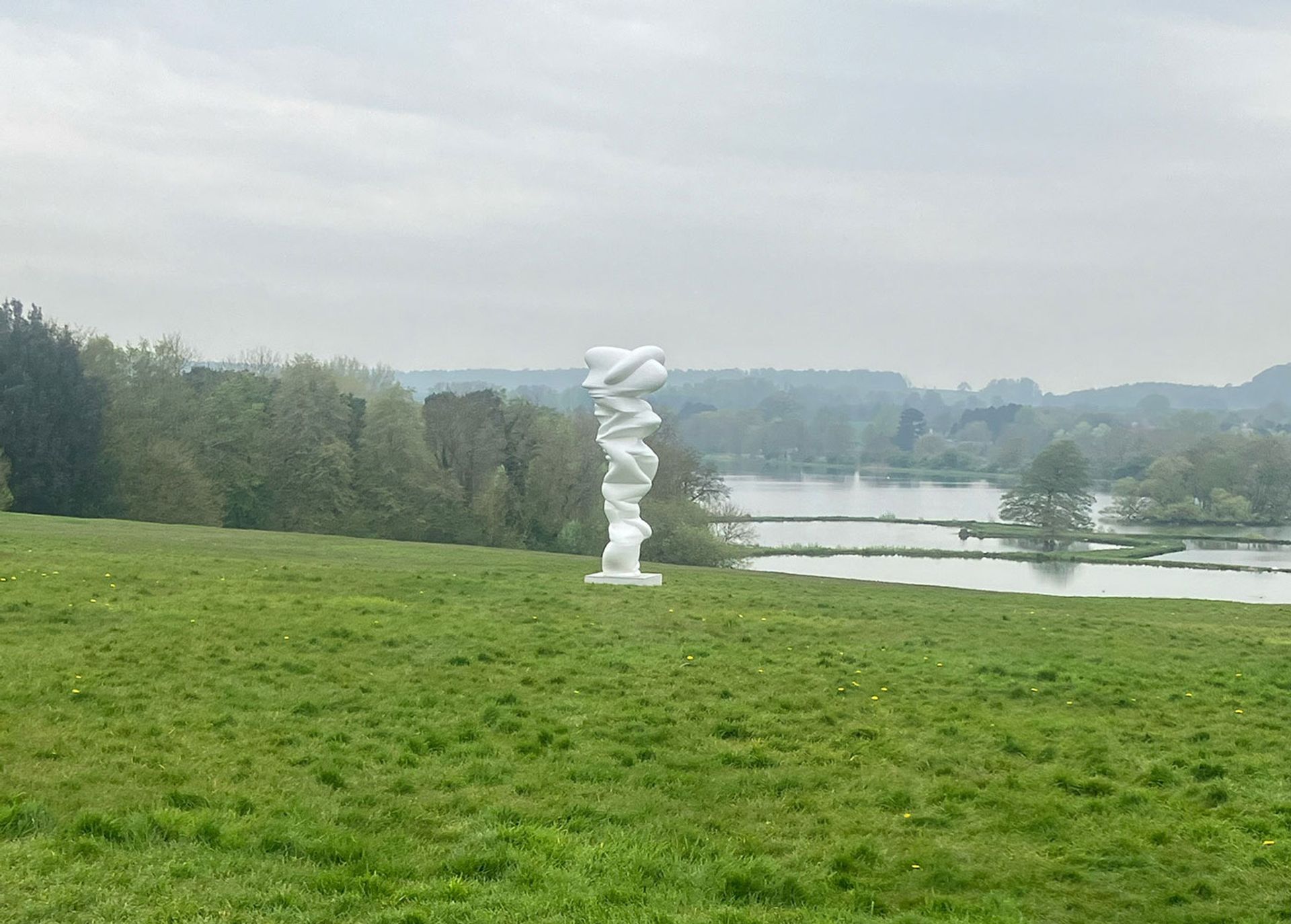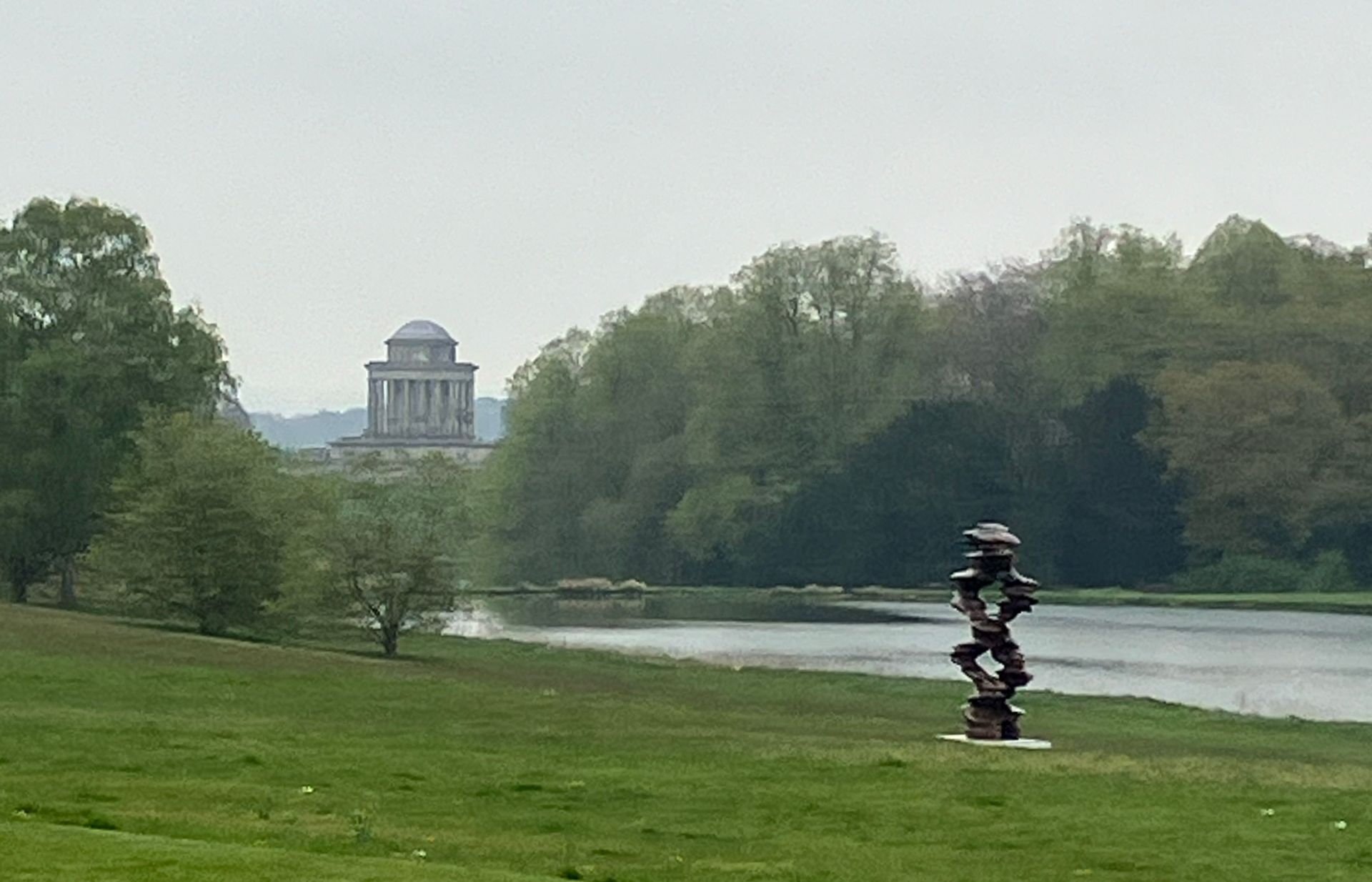Tony Cragg at Castle Howard is the first big contemporary art play at Britain’s best-known, and most-filmed, country house. The exhibition is made up of 10 works by the celebrated Liverpool-born sculptor set in Castle Howard’s matchless gardens and grounds, with views across the Howardian Hills and towards the North York Moors, and 18 indoors (along with 14 works on paper), spaced out across four separate spaces in the vaulting Baroque interiors of the most theatrically composed and positioned of Britain’s great 18th-century treasure palaces.
Castle Howard has been a media star for more than 40 years, thanks to the making of the classic 1981 Granada television adaptation of Evelyn Waugh’s Brideshead Revisited, starring Jeremy Irons, Anthony Andrews and Laurence Olivier; a film remake of the novel in 2008, and then a 2020 episode of the cult Regency TV drama Bridgerton.
The Cragg show has been put on by Nicholas Howard—six times great grandson of Charles Howard, 3rd Earl of Carlisle, the creator, with the architects John Vanburgh and Nicholas Hawksmoor of this showplace for paintings, antiquities and sculpture indoors and out—and his wife, Vicky Barnsley, the publishing pioneer (founder of Fourth Estate and former chief executive of HarperCollins) and sometime trustee of both the Tate Gallery and the National Gallery. The Howards, the urbane, matter-of-fact, stars of the 2022 documentary series Castle Howard: through the seasons, were already familiar with Tony Cragg’s work—in particular his large bronze piece Caldera (2008) in the Markatplatz in Salzburg, Austria—and arranged to work with him after a visit to his long-standing base in Wuppertal, north Germany, with the curator Greville Worthington.
Tony Cragg, Early Forms St Gallen (1997) and the view back to the monumental south front of Castle Howard Photograph: The Art Newspaper
Cragg took them to see the 30-acre sculpture park he has created over the past three decades at the once-abandoned Villa Waldfrieden, outside Wuppertal, where he shows his own work and that of other artists. There, Nicholas Howard recounted at the show’s opening, “we found an historic house, a wonderful deco building, … which Tony has lovingly restored. It was surrounded by glades, by lawns, by trees, by sculptures. I thought, ‘This is looking quite familiar.’ So it seemed … Tony Cragg’s work should be the work that opened up our new era of contemporary work at Castle Howard.”
The Cragg show—where a big-name sculptor’s work is on show both in a 300-year-old landscape and in classically proportioned rooms built for the display of paintings and sculpture—puts Castle Howard in company with some of the 21st-century country house pioneers in the field. These include Stoker and Amanda Cavendish, the Duke and Duchess of Devonshire (noted collectors of contemporary art), at Chatsworth, in Derbyshire—the Howards and the Cavendishes intermarried in the mid 19th-century—and the Marquess of Cholmondeley at Houghton, in Norfolk.
This indoor-outdoor approach, at stately home scale, is one that allows for the vagaries of British summer weather; and that lends itself to art pointing up the connections between the interiors of historic houses and their gardens—to encourage both looking out from a house, and back towards it from the surrounding grounds. It also allows for the showing of a broad scale of work, from chamber pieces to large-scale compositions. Cragg has shown at both Chatsworth, including a 2013 selling show mounted by Sotheby’s, and at Houghton in a full-dress one-man 2021 show, supported by the Thaddaeus Ropac gallery, and curated by Jon Wood (who has curated the Castle Howard show jointly with Greville Worthington).
Delicacy of intervention
At Castle Howard it is striking how well artist, curators and clients have managed the scale, number and placing of the exterior works, so that sightlines and visual connections are enhanced rather than challenged. In achieving this, the site and its history have been both an enticement—to show work in an exceptional mature setting—and a challenge: to beware of making overly dramatic gestures in an existing masterpiece of landscape art.
An organic, sensitive approach is particularly important in the gardens and park at Castle Howard, where neither Capability Brown nor Humphrey Repton, those champions of unrestrained mid to late-18th century landscape redesigns, got to intervene. The result is that the consciously picturesque landscape envisioned by the third earl of Carlisle and his architects—where Hawksmoor’s astounding collonaded mausoleum and Vanburgh’s elegant Temple of the Four Winds draw the eye over sheets of water and along wooded grassy banks—has matured over 300 years into something that clearly evokes the French master Claude Lorrain’s hauntingly atmospheric Classical landscapes from Ovid or Vergil, or of the magical gardens at Tivoli.

Tony Cragg, Senders (2018), seen in the grounds of Castle Howard, looking north over the Great Lake toward the North York Moors national park Photograph: The Art Newspaper
Cragg, who worked with Land Art early in his career, had his break out year in 1988, when he won the Turner Prize after representing Britain at the Venice Biennale. His classic works are built in layers, organised like geological strata of sedimentary rocks, using stacked layers of plywood before being sanded into final form and cast in bronze or fibreglass. It is a decidedly elemental approach, one rooted in nature: “All of the work and the things I make,” Cragg said at the show’s opening, “ is somehow… caught between what human beings make anyway, the stuff we build around us and use, and the nature that surrounds us”.
On the north side of the house, two tall, layered, pieces, placed on the sloping lawn below the entrance courtyard, offer a respectful frame to the far-reaching view to the north across the Great Lake, the village of Coneysthorpe, and towards the moors beyond. Points of View (2018) is in gleaming stainless steel, and catches the eye of the visitor descending the steep slope from Ray Wood to the east of the house. The 6.5-metre tall Senders (2018) is in fibreglass and painted white, a subtle nod to the original appearance of the 17th and 18th-century lead statues of gods and goddesses that are to be found around the gardens and grounds—pieces that were formerly painted white to resemble marble. (This treatment has been restored on the lead statues by John Cheere at Wrest Park, in Bedfordshire.)

Tony Cragg, Masks (2024), in front of the entrance front of Castle Howard Photograph: The Art Newspaper
At the heart of the entrance courtyard stands a monumental new bronze piece, Masks (2024), whose solidity, compressing, in Jon Wood’s words “two forms [head and body-like] into each other to create an image of inseparability”, matches its four-square position and the stony strength of the entrance facade, populated with an array of classical statuary of gods and goddesses, massed in niches and along the house’s parapet.
On the south side of the house, a new painted aluminium piece, Industrial Nature (2024), is most subtly placed at the end of the parterre nearest to the house. Its position in relation to the parterre statuary and to the massive mid 19th-century Atlas fountain is apparent when approaching the work, but only on reaching and examining the piece does the viewer understand its role as a link to the next large exterior work: Runner (2015). This tall stacked piece in bronze stands to the east on ground that slopes down to the south lake and provides a sighter in turn to the Mausoleum, a mile distant, beyond the lake. It is at that moment that the role of Industrial Nature and Runner in drawing out the existing landscape becomes clear.

Channeling Claude Lorrain: Tony Cragg, Runner (2015), set in front of the south lake at Castle Howard, with Nicholas Hawksmoor’s mausoleum in the distance Photograph: The Art Newspaper
Close-up, Runner offers another moment of serendipity: it has openings in its intertwined, stacked, limbs through which the visitor is offered a most picturesque pair of coups d’oeil: in one direction towards the ineffable mausoleum, part of its base nicely obscured by the sloping lake banks; in another back to the 300ft-long south front of the house, adorned with pilasters, the colour of its well-weathered stone thrown into contrast with the sculpture’s rich bronze.
Nicholas Howard caught the character of serendipity and sympathy that has gone into mounting the show—to making landscape and works work in harmony—when he described the experience of living with the exhibition since its recent installation. “I knew one or two of [Cragg’s] pieces already, but having now lived with them, over 20 of them, for a few weeks, it really feels as if they belong here. And with his amazing eye Tony has placed the pieces so that they don’t feel like an intervention, but more something that’s grown up organically around the place.”
Tony Cragg at Castle Howard 3 May to 22 September.Supported by Thaddaeus Ropac




